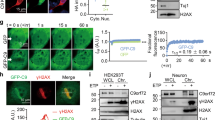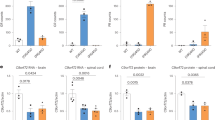Abstract
Expansion of the polyglutamine (polyQ) tract in human TATA-box binding protein (TBP) causes the neurodegenerative disease spinocerebellar ataxia 17 (SCA17). It remains unclear how the polyQ tract regulates normal protein function and induces selective neuropathology in SCA17. We generated transgenic mice expressing polyQ-expanded TBP. These mice showed weight loss, progressive neurological symptoms and neurodegeneration before early death. Expanded polyQ tracts reduced TBP dimerization but enhanced the interaction of TBP with the general transcription factor IIB (TFIIB). In SCA17 transgenic mice, the small heat shock protein HSPB1, a potent neuroprotective factor, was downregulated, and TFIIB occupancy of the Hspb1 promoter was decreased. Overexpression of HSPB1 or TFIIB alleviated mutant TBP-induced neuritic defects. These findings implicate the polyQ domain of TBP in transcriptional regulation and provide insight into the molecular pathogenesis of SCA17.
This is a preview of subscription content, access via your institution
Access options
Subscribe to this journal
Receive 12 print issues and online access
$209.00 per year
only $17.42 per issue
Buy this article
- Purchase on Springer Link
- Instant access to full article PDF
Prices may be subject to local taxes which are calculated during checkout








Similar content being viewed by others
References
Courey, A.J. & Tjian, R. Analysis of Sp1 in vivo reveals multiple transcriptional domains, including a novel glutamine-rich activation motif. Cell 55, 887–898 (1988).
Gerber, H.P. et al. Transcriptional activation modulated by homopolymeric glutamine and proline stretches. Science 263, 808–811 (1994).
Lee, T.I. & Young, R.A. Transcription of eukaryotic protein-coding genes. Annu. Rev. Genet. 34, 77–137 (2000).
Bondareva, A.A. & Schmidt, E.E. Early vertebrate evolution of the TATA-binding protein, TBP. Mol. Biol. Evol. 20, 1932–1939 (2003).
Bruni, A.C. et al. Behavioral disorder, dementia, ataxia, and rigidity in a large family with TATA box-binding protein mutation. Arch. Neurol. 61, 1314–1320 (2004).
Koide, R. et al. A neurological disease caused by an expanded CAG trinucleotide repeat in the TATA-binding protein gene: a new polyglutamine disease? Hum. Mol. Genet. 8, 2047–2053 (1999).
Nakamura, K. et al. SCA17, a novel autosomal dominant cerebellar ataxia caused by an expanded polyglutamine in TATA-binding protein. Hum. Mol. Genet. 10, 1441–1448 (2001).
Rolfs, A. et al. Clinical features and neuropathology of autosomal dominant spinocerebellar ataxia (SCA17). Ann. Neurol. 54, 367–375 (2003).
Toyoshima, Y. et al. SCA17 homozygote showing Huntington's disease-like phenotype. Ann. Neurol. 55, 281–286 (2004).
Bauer, P. et al. Trinucleotide repeat expansion in SCA17/TBP in white patients with Huntington's disease-like phenotype. J. Med. Genet. 41, 230–232 (2004).
Zoghbi, H.Y. & Orr, H.T. Glutamine repeats and neurodegeneration. Annu. Rev. Neurosci. 23, 217–247 (2000).
Riley, B.E. & Orr, H.T. Polyglutamine neurodegenerative diseases and regulation of transcription: assembling the puzzle. Genes Dev. 20, 2183–2192 (2006).
Burley, S.K. & Roeder, R.G. Biochemistry and structural biology of transcription factor IID (TFIID). Annu. Rev. Biochem. 65, 769–799 (1996).
Schilling, G. et al. Intranuclear inclusions and neuritic aggregates in transgenic mice expressing a mutant N-terminal fragment of huntingtin. Hum. Mol. Genet. 8, 397–407 (1999).
La Spada, A.R. et al. Polyglutamine-expanded ataxin-7 antagonizes CRX function and induces cone-rod dystrophy in a mouse model of SCA7. Neuron 31, 913–927 (2001).
Fujigasaki, H. et al. CAG repeat expansion in the TATA box-binding protein gene causes autosomal dominant cerebellar ataxia. Brain 124, 1939–1947 (2001).
Jackson-Fisher, A.J., Chitikila, C., Mitra, M. & Pugh, B.F. A role for TBP dimerization in preventing unregulated gene expression. Mol. Cell 3, 717–727 (1999).
Schmidt, E.E., Bondareva, A.A., Radke, J.R. & Capecchi, M.R. Fundamental cellular processes do not require vertebrate-specific sequences within the TATA-binding protein. J. Biol. Chem. 278, 6168–6174 (2003).
Evgrafov, O.V. et al. Mutant small heat-shock protein 27 causes axonal Charcot-Marie-Tooth disease and distal hereditary motor neuropathy. Nat. Genet. 36, 602–606 (2004).
Williams, K.L., Rahimtula, M. & Mearow, K.M. Hsp27 and axonal growth in adult sensory neurons in vitro. BMC Neurosci. [online] 6, 24 (2005).
Akbar, M.T. et al. The neuroprotective effects of heat shock protein 27 overexpression in transgenic animals against kainate-induced seizures and hippocampal cell death. J. Biol. Chem. 278, 19956–19965 (2003).
Sharp, P. et al. Heat shock protein 27 rescues motor neurons following nerve injury and preserves muscle function. Exp. Neurol. 198, 511–518 (2006).
Lasek, K. et al. Morphological basis for the spectrum of clinical deficits in spinocerebellar ataxia 17 (SCA17). Brain 129, 2341–2352 (2006).
Maltecca, F. et al. Intergenerational instability and marked anticipation in SCA-17. Neurology 61, 1441–1443 (2003).
Mittal, V. & Hernandez, N. Role for the amino-terminal region of human TBP in U6 snRNA transcription. Science 275, 1136–1140 (1997).
Seipel, K., Georgiev, O., Gerber, H.P. & Schaffner, W. Basal components of the transcription apparatus (RNA polymerase II, TATA-binding protein) contain activation domains: is the repetitive C-terminal domain (CTD) of RNA polymerase II a “portable enhancer domain”? Mol. Reprod. Dev. 39, 215–225 (1994).
Lee, M. & Struhl, K. A severely defective TATA-binding protein-TFIIB interaction does not preclude transcriptional activation in vivo. Mol. Cell. Biol. 17, 1336–1345 (1997).
Tansey, W.P. & Herr, W. Selective use of TBP and TFIIB revealed by a TATA-TBP-TFIIB array with altered specificity. Science 275, 829–831 (1997).
Butler, R. & Bates, G.P. Histone deacetylase inhibitors as therapeutics for polyglutamine disorders. Nat. Rev. Neurosci. 7, 784–796 (2006).
Arrasate, M., Mitra, S., Schweitzer, E.S., Segal, M.R. & Finkbeiner, S. Inclusion body formation reduces levels of mutant huntingtin and the risk of neuronal death. Nature 431, 805–810 (2004).
Lam, Y.C. et al. ATAXIN-1 interacts with the repressor capicua in its native complex to cause SCA1 neuropathology. Cell 127, 1335–1347 (2006).
Gatchel, J.R. & Zoghbi, H.Y. Diseases of unstable repeat expansion: mechanisms and common principles. Nat. Rev. Genet. 6, 743–755 (2005).
Roeder, R.G. Transcriptional regulation and the role of diverse coactivators in animal cells. FEBS Lett. 579, 909–915 (2005).
Gaestel, M., Gotthardt, R. & Muller, T. Structure and organisation of a murine gene encoding small heat-shock protein Hsp25. Gene 128, 279–283 (1993).
Williams, K.L., Rahimtula, M. & Mearow, K.M. Heat shock protein 27 is involved in neurite extension and branching of dorsal root ganglion neurons in vitro. J. Neurosci. Res. 84, 716–723 (2006).
Chang, W.H. et al. Dynamic expression of Hsp27 in the presence of mutant ataxin-3. Biochem. Biophys. Res. Commun. 336, 258–267 (2005).
Tsai, H.F., Lin, S.J., Li, C. & Hsieh, M. Decreased expression of Hsp27 and Hsp70 in transformed lymphoblastoid cells from patients with spinocerebellar ataxia type 7. Biochem. Biophys. Res. Commun. 334, 1279–1286 (2005).
Wyttenbach, A. et al. Heat shock protein 27 prevents cellular polyglutamine toxicity and suppresses the increase of reactive oxygen species caused by huntingtin. Hum. Mol. Genet. 11, 1137–1151 (2002).
Armstrong, C.L. et al. Constitutive expression of heat shock protein HSP25 in the central nervous system of the developing and adult mouse. J. Comp. Neurol. 434, 262–274 (2001).
Dierick, I., Irobi, J., De Jonghe, P. & Timmerman, V. Small heat shock proteins in inherited peripheral neuropathies. Ann. Med. 37, 413–422 (2005).
Li, H., Li, S.H., Yu, Z.X., Shelbourne, P. & Li, X.J. Huntingtin aggregate-associated axonal degeneration is an early pathological event in Huntington's disease mice. J. Neurosci. 21, 8473–8481 (2001).
Parker, J.A. et al. Expanded polyglutamines in Caenorhabditis elegans cause axonal abnormalities and severe dysfunction of PLM mechanosensory neurons without cell death. Proc. Natl. Acad. Sci. USA 98, 13318–13323 (2001).
Michalik, A., Kazantsev, A. & Van Broeckhoven, C. Method to introduce stable, expanded, polyglutamine-encoding CAG/CAA trinucleotide repeats into CAG repeat-containing genes. Biotechniques 31, 250-252–254 (2001).
Taggart, A.K. & Pugh, B.F. Dimerization of TFIID when not bound to DNA. Science 272, 1331–1333 (1996).
Li, S.H. et al. Interaction of Huntington disease protein with transcriptional activator Sp1. Mol. Cell. Biol. 22, 1277–1287 (2002).
Acknowledgements
We thank C.-E. Wang and H.H. Nguyen for technical assistance, K. Smith for instruction on chromatin immunoprecipitation, A.R. La Spada (University of Washington Medical Center) and D.R. Borchelt (University of Florida College of Medicine) for the prion promoter plasmid, and A. Michalik (University of Antwerp) for the CAA/CAG repeat oligonucleotide. This work was supported by US National Institutes of Health grants (NS045016, NS41669, AG19206, NS36232).
Author information
Authors and Affiliations
Contributions
M.J.F. characterized transgenic mice, examined transgene expression as well as biochemical, transcriptional, and pathological changes in animal and cell models, and wrote the manuscript; A.G.S. characterized stably transfected PC12 cells; Z.-H.F. performed immunohistochemical and electron microscopic studies; E.G.W. and S.T.W. conducted and analyzed microarray experiments; S.H.L. and X.-J.L. established transgenic mice and stably transfected cell lines, supervised the project, analyzed data and wrote the manuscript.
Corresponding authors
Supplementary information
Supplementary Text and Figures
Supplementary Figures 1–7, Tables 1 and 2, and Methods (PDF 2568 kb)
Rights and permissions
About this article
Cite this article
Friedman, M., Shah, A., Fang, ZH. et al. Polyglutamine domain modulates the TBP-TFIIB interaction: implications for its normal function and neurodegeneration. Nat Neurosci 10, 1519–1528 (2007). https://doi.org/10.1038/nn2011
Received:
Accepted:
Published:
Issue Date:
DOI: https://doi.org/10.1038/nn2011
This article is cited by
-
Functional implications of paralog genes in polyglutamine spinocerebellar ataxias
Human Genetics (2023)
-
Trimeric complexes of Antp-TBP with TFIIEβ or Exd modulate transcriptional activity
Hereditas (2022)
-
Consensus Paper: Strengths and Weaknesses of Animal Models of Spinocerebellar Ataxias and Their Clinical Implications
The Cerebellum (2022)
-
Calpains as novel players in the molecular pathogenesis of spinocerebellar ataxia type 17
Cellular and Molecular Life Sciences (2022)
-
Frequency of spinocerebellar ataxia mutations in patients with multiple system atrophy
Clinical Autonomic Research (2021)



